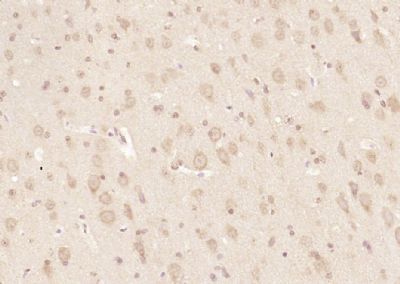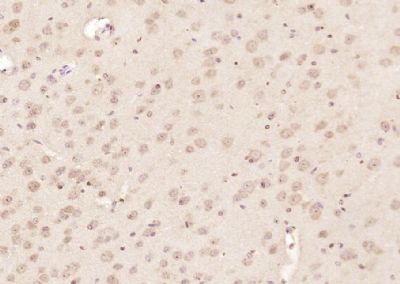RRAGA + RRAGB Polyclonal Antibody
Purified Rabbit Polyclonal Antibody (Pab)
- SPECIFICATION
- CITATIONS
- PROTOCOLS
- BACKGROUND

Application
| IHC-P, IHC-F, IF, ICC, E |
|---|---|
| Primary Accession | Q7L523 |
| Reactivity | Rat, Pig, Dog |
| Host | Rabbit |
| Clonality | Polyclonal |
| Calculated MW | 37 KDa |
| Physical State | Liquid |
| Immunogen | KLH conjugated synthetic peptide derived from human RRAGA and RRAGB |
| Epitope Specificity | 231-313/313 |
| Isotype | IgG |
| Purity | affinity purified by Protein A |
| Buffer | 0.01M TBS (pH7.4) with 1% BSA, 0.02% Proclin300 and 50% Glycerol. |
| SUBCELLULAR LOCATION | Cytoplasm. Nucleus. Lysosome. Note=Predominantly cytoplasmic. May shuttle between the cytoplasm and nucleus, depending on the bound nucleotide state. Colocalizes in vivo with adenovirus E3-14.7K mainly to the cytoplasm especially near the nuclear membrane and in discrete foci on or near the plasma membrane. |
| SIMILARITY | Belongs to the GTR/RAG GTP-binding protein family. |
| SUBUNIT | Binds GTP. Can occur as a homodimer or as a heterodimer with RRAGC or RRAGD in a sequence-independent manner; heterodimerization stabilizes PPAG proteins. In complex with RRAGC, but not with RRAGB, interacts with RPTOR. The GTP-bound form of RRAGA interacts with NOL8. Interacts with adenovirus E3 14.7 kDa protein. |
| Important Note | This product as supplied is intended for research use only, not for use in human, therapeutic or diagnostic applications. |
| Background Descriptions | Involved in the RCC1/Ran-GTPase pathway. RRAGA may play a direct role in a TNF-alpha signaling pathway leading to induction of cell death. May alternatively act as a cellular target for adenovirus E3-14.7K, an inhibitor of TNF-alpha functions, thereby affecting cell death. Has guanine nucleotide-binding activity but undetectable intrinsic GTPase activity. biquitously expressed with highest levels of expression in skeletal muscle, heart, and brain. |
| Gene ID | 10670 |
|---|---|
| Other Names | Ras-related GTP-binding protein A, Rag A, RagA, 3.6.5.-, Adenovirus E3 14.7 kDa-interacting protein 1, FIP-1, RRAGA (HGNC:16963) |
| Target/Specificity | Ubiquitously expressed with highest levels of expression in skeletal muscle, heart, and brain. |
| Dilution | IHC-P=1:100-500,IHC-F=1:100-500,ICC=1:100-500,IF=1:100-500,ELISA=1:5000-10000 |
| Format | 0.01M TBS(pH7.4), 0.09% (W/V) sodium azide and 50% Glyce |
| Storage | Store at -20 ℃ for one year. Avoid repeated freeze/thaw cycles. When reconstituted in sterile pH 7.4 0.01M PBS or diluent of antibody the antibody is stable for at least two weeks at 2-4 ℃. |
| Name | RRAGA (HGNC:16963) |
|---|---|
| Function | Guanine nucleotide-binding protein that plays a crucial role in the cellular response to amino acid availability through regulation of the mTORC1 signaling cascade (PubMed:20381137, PubMed:24095279, PubMed:25936802, PubMed:31601708, PubMed:31601764, PubMed:38103557). Forms heterodimeric Rag complexes with RagC/RRAGC or RagD/RRAGD and cycles between an inactive GDP-bound and an active GTP-bound form: RagA/RRAGA is in its active form when GTP-bound RagA/RRAGA forms a complex with GDP-bound RagC/RRAGC (or RagD/RRAGD) and in an inactive form when GDP-bound RagA/RRAGA heterodimerizes with GTP-bound RagC/RRAGC (or RagD/RRAGD) (PubMed:20381137, PubMed:24095279, PubMed:25936802, PubMed:31601708, PubMed:31601764, PubMed:32868926). In its GTP-bound active form, promotes the recruitment of mTORC1 to the lysosomes and its subsequent activation by the GTPase RHEB (PubMed:20381137, PubMed:25936802, PubMed:31601708, PubMed:31601764). Involved in the RCC1/Ran-GTPase pathway (PubMed:9394008). May play a direct role in a TNF-alpha signaling pathway leading to induction of cell death (PubMed:8995684). |
| Cellular Location | Cytoplasm. Nucleus. Lysosome membrane Note=Predominantly cytoplasmic (PubMed:8995684, PubMed:9394008) Recruited to the lysosome surface by the Ragulator complex (PubMed:20381137, PubMed:28935770, PubMed:29158492). May shuttle between the cytoplasm and nucleus, depending on the bound nucleotide state (PubMed:8995684, PubMed:9394008). Colocalizes in vivo with adenovirus E3-14.7K mainly to the cytoplasm especially near the nuclear membrane and in discrete foci on or near the plasma membrane (PubMed:8995684). |
| Tissue Location | Ubiquitously expressed with highest levels of expression in skeletal muscle, heart, and brain |

Thousands of laboratories across the world have published research that depended on the performance of antibodies from Abcepta to advance their research. Check out links to articles that cite our products in major peer-reviewed journals, organized by research category.
info@abcepta.com, and receive a free "I Love Antibodies" mug.
Provided below are standard protocols that you may find useful for product applications.
If you have used an Abcepta product and would like to share how it has performed, please click on the "Submit Review" button and provide the requested information. Our staff will examine and post your review and contact you if needed.
If you have any additional inquiries please email technical services at tech@abcepta.com.













 Foundational characteristics of cancer include proliferation, angiogenesis, migration, evasion of apoptosis, and cellular immortality. Find key markers for these cellular processes and antibodies to detect them.
Foundational characteristics of cancer include proliferation, angiogenesis, migration, evasion of apoptosis, and cellular immortality. Find key markers for these cellular processes and antibodies to detect them. The SUMOplot™ Analysis Program predicts and scores sumoylation sites in your protein. SUMOylation is a post-translational modification involved in various cellular processes, such as nuclear-cytosolic transport, transcriptional regulation, apoptosis, protein stability, response to stress, and progression through the cell cycle.
The SUMOplot™ Analysis Program predicts and scores sumoylation sites in your protein. SUMOylation is a post-translational modification involved in various cellular processes, such as nuclear-cytosolic transport, transcriptional regulation, apoptosis, protein stability, response to stress, and progression through the cell cycle. The Autophagy Receptor Motif Plotter predicts and scores autophagy receptor binding sites in your protein. Identifying proteins connected to this pathway is critical to understanding the role of autophagy in physiological as well as pathological processes such as development, differentiation, neurodegenerative diseases, stress, infection, and cancer.
The Autophagy Receptor Motif Plotter predicts and scores autophagy receptor binding sites in your protein. Identifying proteins connected to this pathway is critical to understanding the role of autophagy in physiological as well as pathological processes such as development, differentiation, neurodegenerative diseases, stress, infection, and cancer.



